
The hour of the wolfby Dwayne A. Day
|
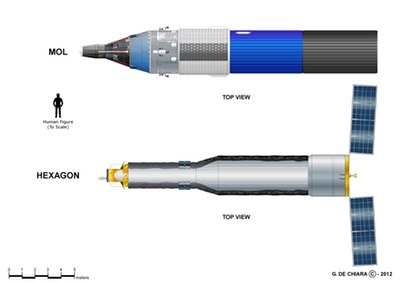 An illustration comparing the HEXAGON spy satellite (bottom) with the cancelled Manned Orbiting Laboratory. [larger version] (credit: Giuseppe De Chiara) |
The KH-9 HEXAGON was a robotic spacecraft that started after MOL. Although the CIA conducted studies and funded hardware experiments in 1963, it was not until May 1966 that the Perkin-Elmer Corporation was awarded a contract to develop the camera system. The HEXAGON had a different mission than MOL-DORIAN. It was supposed to scan huge amounts of territory, recording images on long strips of film that were then returned to Earth in large reentry vehicles, essentially a “search” system, as compared to the MOL-DORIAN “spotting” system. HEXAGON was a CIA-led program.
Both spacecraft were going to be large, requiring powerful Titan III rockets to loft them into polar orbits. And both were expensive. They were also under development at a time when the Johnson administration was escalating the war in Vietnam, increasing the strain on the defense budget. By 1967, critics who had knowledge of these classified systems were increasingly questioning the ability of the country to afford both of them.
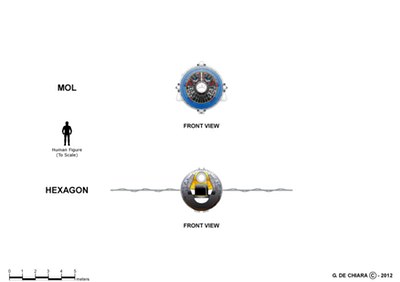 An illustration comparing the HEXAGON spy satellite (bottom) with the cancelled Manned Orbiting Laboratory. [larger version] (credit: Giuseppe De Chiara) |
HEXAGON was not declassified until September of last year. MOL remains partially classified, including all the interesting parts. But some newly declassified documents add more details. For example, the first declassified image of the overall MOL configuration was recently released, confirming the horizontal orientation of the spacecraft. A 1965 document also refers to increasing the size of the MOL primary mirror from 152 to 178 centimeters (60 to 70 inches)—the same size as the ground-based Multi-Mirror Telescope that ultimately inherited the leftover MOL mirrors.
A declassified HEXAGON history for the first time officially acknowledges the NRO’s role in the MOL program, the spacecraft’s primary reconnaissance mission, and the name of the DORIAN camera system. It sheds a little more light on the clash between these two titanic programs.
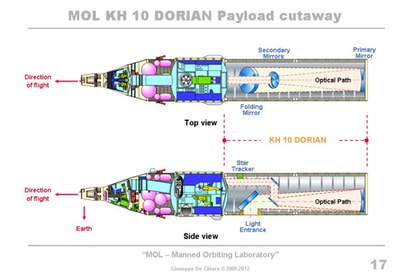 A cutaway illustration showing the interior of the MOL. [larger version] (credit: Giuseppe De Chiara) |
According to the history, MOL-DORIAN’s high-resolution capability was being challenged by 1968 with the introduction of the GAMBIT-3 reconnaissance system. The earlier GAMBIT-1 system had been replaced by the GAMBIT-3, or “G cubed,” spacecraft by 1967, and although its capabilities remain classified to this day, it clearly was getting close to the MOL-DORIAN’s resolution limits. However, it was HEXAGON that became the primary target of critics by mid-1968. The reason appears to be that HEXAGON’s costs were high, and many people were skeptical of its technical feasibility.
In January 1969 a new administration took over the White House and their newly-appointed Pentagon officials soon began looking at the two large reconnaissance systems with an eye to eliminating one. They finally faced their showdown.
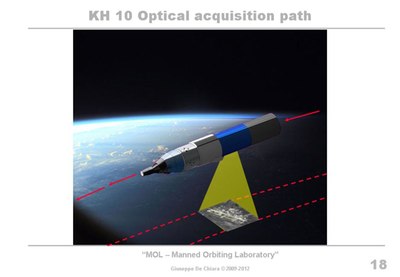 An illustration showing hot MOL would have collected imagery. [larger version] (credit: Giuseppe De Chiara) |
Robert Mayo, the new Director of the Bureau of the Budget (the predecessor to the Office of Management and Budget) soon proposed cancelling HEXAGON and substituting a combination of GAMBIT-3 and an upgraded version of the proven CORONA search satellite. Mayo initially received no support for his proposal, but he made it again to President Nixon in March, and on April 9, 1969, Nixon ordered HEXAGON cancelled and approved completion of MOL-DORIAN.
Richard Helms, the Director of Central Intelligence who had stayed over from the Johnson Administration, convinced Nixon to delay the HEXAGON cancellation for two weeks. Helms and Deputy Secretary of Defense David Packard then formally objected to the cancellation, convincing Reid Mayo to reverse his position on April 21. By late April they also convinced Secretary of Defense Melvin Laird. Apparently, at this point, the primary argument in favor of HEXAGON over MOL-DORIAN was that the former was essential for monitoring arms control treaties. DORIAN would be essentially useless for this task, because astronauts could only photograph small amounts of territory, missing all the other things that could be only a few kilometers away. HEXAGON covered so much territory that there was simply no place to hide any forbidden bombers or missiles.
Helms and Packard soon had an even more powerful weapon to bolster their argument. In early May, an independent intelligence advisory panel delivered a report on MOL-DORIAN. Although that report, like so much else about MOL, remains classified, it apparently recommended cancelling the manned part of the MOL program and using optics derived from DORIAN in a robotic system (which was ultimately never built). The panel also recommended diverting money from the cancelled program to development of a “real-time-readout” system that would beam its images back to Earth via relay satellites. MOL had made itself vulnerable to such a recommendation because it was behind schedule and over budget, and by 1969 the robotic reconnaissance systems were so impressive it was difficult to argue that humans could contribute anything to the satellite reconnaissance mission.
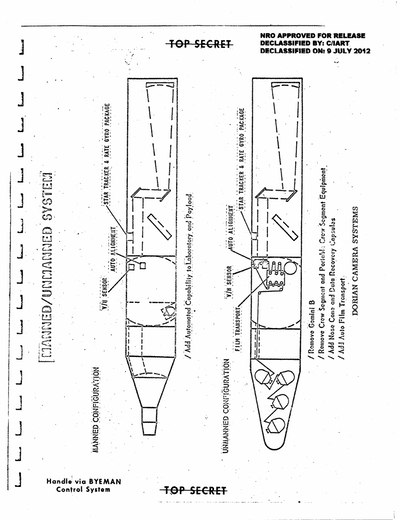 A declassified document showing a proposed, but never developed, unmanned version of the MOL. [larger version] |
Although the arms control argument had stayed the initial cancellation of HEXAGON, by May 1969 Nixon was apparently so intrigued by the real-time-readout system that he decided to follow the advisory panel’s recommendation and cancel MOL in order to fund the new system. Secretary of Defense Laird announced the MOL cancellation on the morning of June 10, 1969, stunning many people involved in the program.
In retrospect, Nixon made the right decision and for the right reasons. HEXAGON went on to be a highly successful system vital for arms control, and the real-time system, KENNEN, revolutionized intelligence collection. We still know relatively little about the MOL-DORIAN program, but the fact that the government has now revealed the “fact of” DORIAN and NRO’s association with it means that we will likely soon begin to learn a lot more.